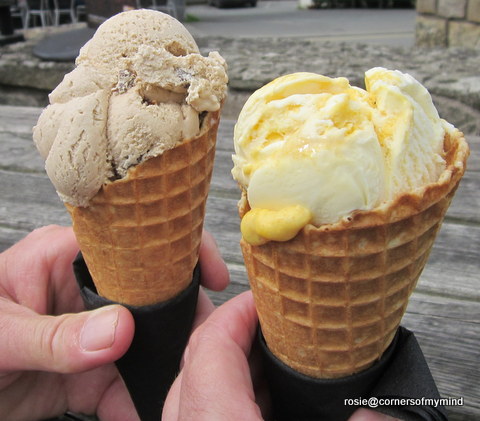Where did September go? Already it's the last day of the month and the days seem to have gone by so quickly. We've had a short break in Wales, taken a few walks and visited a garden or two and a couple of buildings over the Heritage Open Days weekend but mostly we've been at home pottering in the garden and making jam and chutney from the left overs of the produce we have grown.
I think all the photos I've used were taken in September so here are my selection for this month's Scavenger hunt organised by I Live, I Love, I Craft, I am Me blog - here
Shut - a gate in RSPB Combes Valley Nature Reserve, near Leek in the Staffordshire Moorlands. Taken on a recent Sunday morning walk there.
Copper - Kettle on a shelf in the Worker's Cottage at Abbeydale Industrial Hamlet, Dore, Sheffield which we visited on 20th September.
Wrist- The wrist from the statue of local author Arnold Bennett outside the Potteries Museum and Art Gallery, Bethesda Street, Hanley, Stoke-on-Trent which we visited on Thursday last week.
Copper - Kettle on a shelf in the Worker's Cottage at Abbeydale Industrial Hamlet, Dore, Sheffield which we visited on 20th September.
Wrist- The wrist from the statue of local author Arnold Bennett outside the Potteries Museum and Art Gallery, Bethesda Street, Hanley, Stoke-on-Trent which we visited on Thursday last week.
Quarter - a quarter of a Cox's apple, very crisp and tasty it was too.
It begins with a C - Caterpillar, a fox moth caterpillar found on a much used path leading to a shop and cafe at the top of Horseshoe Pass near Llangollen in Wales. We managed to get it to crawl onto a leaflet we'd just picked up in the shop and we moved it to safety otherwise it would have been trampled by huge biker boots as at least twenty bikes had just arrived in the car park nearby.
Foam - I stood for ages watching the sea hit the rocks at the end of Llanbedrog beach on the Llyn Peninsula where we had walked as far as we could. I was determined to touch the rocks before we started to go back towards the village.
Scarf - my newest scarf which I've very attached to at the moment. I was sitting opposite Paul when he took this photo during our trip on the Welsh Highland railway from Porthmadog to Caernarvon earlier this month.
Line - the end of the line at Caernarvon on the Welsh Highland Railway. We had an hour in the town before the train returned to Porthmadog through the mist covered mountains, rain soaked landscape and flooded roads and fields.
Nostalgia - when I saw the rag rugs made by the Hamlet Haberdashers Textile Group in the worker's cottage at the Abbeydale Industrial Hamlet Museum I was transported back to my grandmother's house. When I was a child I used to spend a few days there sometimes and I remember she had several rag rugs including one in front of the hearth of a big black range which she kept polished and where she used to leave bread to rise covered with a clean white tea towel. She made the rugs herself using lots of scraps of material from old frocks, shirts and pinafores with the dark edges made from an old gabardine macintosh. She used to make the rugs sitting at the huge, scrubbed white kitchen table.
My Own Choice - Gorgeous Dahlias in Mrs Bateman's Dahlia Walk at Biddulph Grange Gardens which is our nearest National Trust Property.
Click on the link below to find more bloggers who are taking part this month.
Line - the end of the line at Caernarvon on the Welsh Highland Railway. We had an hour in the town before the train returned to Porthmadog through the mist covered mountains, rain soaked landscape and flooded roads and fields.
Nostalgia - when I saw the rag rugs made by the Hamlet Haberdashers Textile Group in the worker's cottage at the Abbeydale Industrial Hamlet Museum I was transported back to my grandmother's house. When I was a child I used to spend a few days there sometimes and I remember she had several rag rugs including one in front of the hearth of a big black range which she kept polished and where she used to leave bread to rise covered with a clean white tea towel. She made the rugs herself using lots of scraps of material from old frocks, shirts and pinafores with the dark edges made from an old gabardine macintosh. She used to make the rugs sitting at the huge, scrubbed white kitchen table.
My Own Choice - Gorgeous Dahlias in Mrs Bateman's Dahlia Walk at Biddulph Grange Gardens which is our nearest National Trust Property.
Click on the link below to find more bloggers who are taking part this month.















































